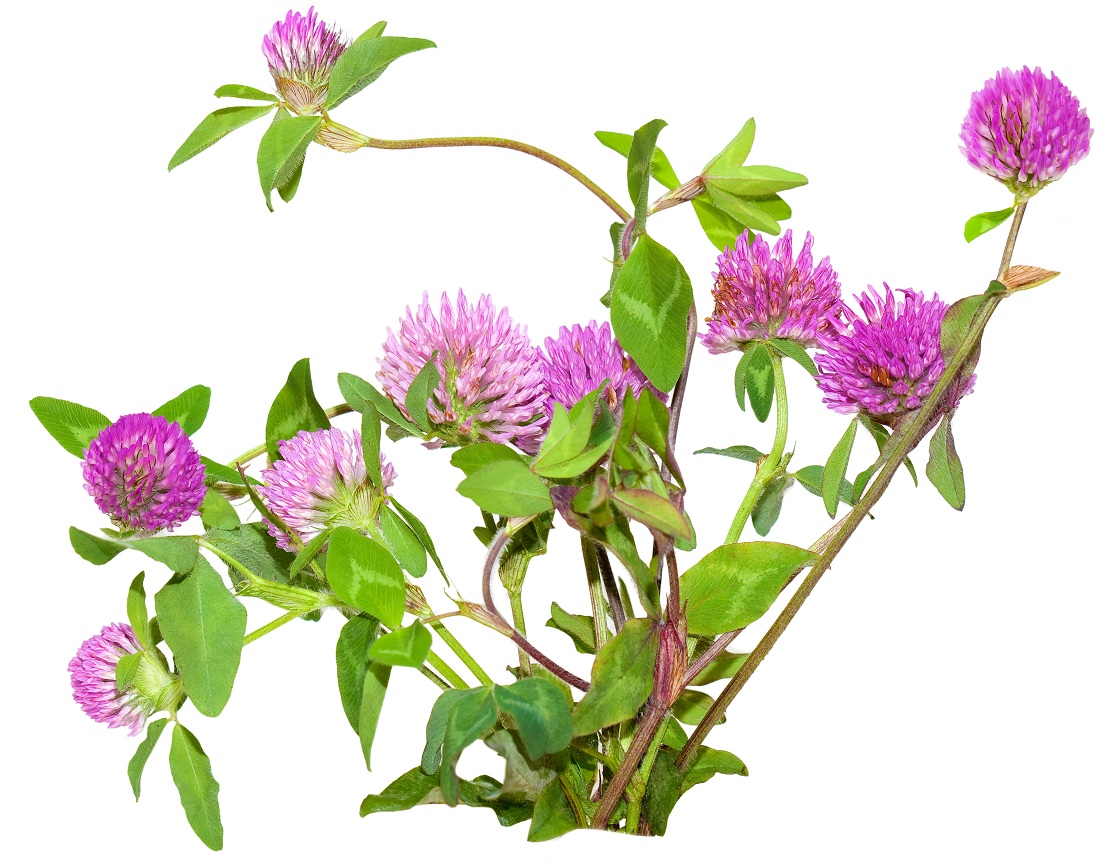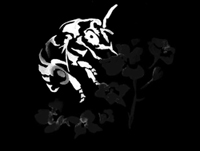Clover (Trifolium spp.)

Mating & Breeding System: Clovers are important as livestock forage, green manure and cover crops, and also as honey plants. Red clover (Trifolium pratense), white clover (T. repens), and alsike clover (T. hybridum) are the major species grown in Ontario, although numerous other species of Trifolium are cultivated in various parts of the world.
The flowers of clover share a typical legume structure, although the tubular flowers are small and narrow, and grouped together in inflorescences. The anthers release the pollen inside the bud prior to opening. When a flower visitor lands on the flower, its weight causes the anthers and stigma to extend forward and press against the head of the visitor. Afterwards, the sexual structures return to their original position, allowing the same flower to deliver pollen repeatedly.
In general, all three species of clover are self-sterile, although some varieties (especially in white clover) are self-fertile. Insect pollinators are required for successful seed set.
Pollination, Quality & Yield: Clover species offer desirable resources to honeybees, but they must exert a considerable effort to access them due to the shape of the flower. Some studies have found that adding honey bees can significantly increase yields in clover seed crops.
Alsike and red clovers require long-tongued bees (mostly honey bees and bumble bees) for pollination, as these are the only insects that can reach the nectar. Smaller insects may be able to access the pollen. Yield of alsike clover is improved 10-fold or more with insect pollinators.
Red clover is predominantly pollinated by long-tongued bumble bees, as the tongues of honey bees are too short to reach the nectar in this species - unless the nectar levels are especially high. Honey bees forage more slowly than bumble bees, although several studies in red clover in Oregon found that bumble bees and honey bees performed similarly in pollinating the crop.
Short-tongued bumble bees will often “rob” clover species with long, narrow florets (i.e., they bite their way through the petals to access the nectar without pollinating the flower). This happens most often in red clover, and it can have a negative impact on seed production. There have been efforts to breed red clover with shorter florets that will allow a wider range of visitors, including honey bees, access to the nectar.
Florets in white clover are much shallower, allowing a wider variety of insects to access the nectar and act as pollinators. Similar to the other clover species, bee pollination greatly increases the seed yield, leading to 30-fold or more increases.
Weather conditions during bloom can play an important role in clover pollination, affecting not only insect activity but nectar production and fertilization. As well, micronutrients (particularly boron) have a strong influence on nectar production, which in turn can influence pollinator visits and seed production. Growers with pollination problems may wish to contact OMAFRA to arrange a soil test.
Pollinated flowers soon wilt and lose their colour, so a field full of colourful, blooming flower heads is an indication of poor pollination.
Pollination Recommendations: Placing honey bee hives on the fields is the standard practice for clover pollination. A highly desirable honey is produced in the process. However, commercial production fields have so many blooms that full pollination by honey bees may be prohibitively expensive.
For alsike clover, the recommendation is 2.5-8 honey bee colonies per hectare for adequate pollination. (The alfalfa leafcutter bee has also been found to be an effective pollinator of alsike clover.)
For red clover, adding honey bees at a rate of 2.5-10 colonies per hectare is recommended for large fields. Although bumble bees are rarely present in sufficient numbers to pollinate clover at a commercial scale, their populations should be encouraged because they are much better at foraging in the deep red florets than honey bees.
For white clover, honey bee stocking recommendations are 1-8 honey bee colonies per hectare.
Species of sweet clover, which may also be grown for seed in Ontario, are not true clovers but are legumes in the genus Melilotus. However, honey bee stocking recommendations are similar at 2.5-8 colonies per hectare.
Wild bees, especially long-tongued species, are effective pollinators but they are rarely present in sufficient numbers to pollinate commercial fields. Studies suggest that there is value in conserving bumble bees and other wild bees in clover fields, in addition to renting honey bees hives.
References
Bohart, G.E. 1957. Pollination of alfalfa and red clover. Annual Review of Entomology 2:355-380.
Dunham, W.E. 1957. Pollination of clover fields. Gleanings in Bee Culture 85:218-219.
Fairey, D.T. & Lefkovitch, L.P. 1993b. Bombus and other bee pollinators in Trifolium hybridum seed fields. Journal of Applied Seed Production 11:87-89.
Fischer, R.L. 1954. Honeybees aid production of alsike clover seed. Minnesota Farm and Home Science 11:7-9.
Goodman, R.D. & Williams, A.E. 1994. Honeybee pollination of white clover (Trifolium repens L.) cv Haifa. Australian Journal of Experimental Agriculture 34:1121-1123.
Green, H.B. 1957. White clover pollination with low honeybee population. Journal of Economic Entomology 50:318-320.
Holm, S.N. 1966. The utilization and management of bumble bees for red clover and alfalfa production. Annual Review of Entomology 11:155-182.
Johnson, W.C. & Wear, J.I. 1967. Effect of boron on white clover (Trifolium repens l.) seed production. Agronomy Journal 59:205-206.
Kevan, P.G. 1988. Pollination, crops and bees. OMAFRA publication 72.
Oertel, E. 1961. Honeybees in production of white clover seed in the southern States. American Bee Journal 101:96-99.
Peterson, A.G., Furgala, B., & Holdaway, F.G. 1960. Pollination of red clover in Minnesota. Journal of Economic Entomology 53:546-550.
Rao, S. & Stephen, W.P. 2009. Bumble bee pollinators in red clover seed production. Crop Science 49:2207-2214.
Scott-Dupree, C.D., Winston, M., Hergert, G., Jay, S.C., Nelson, D., Gates, J., Termeer, B., & Otis, G. 1995. A guide to managing bees for crop pollination. Canadian Association of Professional Apiculturists, Aylesford NS.
Smith R.H. & Johnson, W.C. 1969. Effect of boron on white clover nectar production. Crop Science 9:75.
Turkington, R. & Burdon, J. J. 1983. The biology of Canadian weeds. 54. Trifolium repens L. Canadian Journal of Plant Science 63:243-266.
Wermuth, K.H. & Dupont, Y.L. 2010. Effects of field characteristics on abundance of bumblebees (Bombus spp.) and seed yield in red clover fields. Apidologie 41:657-666.
